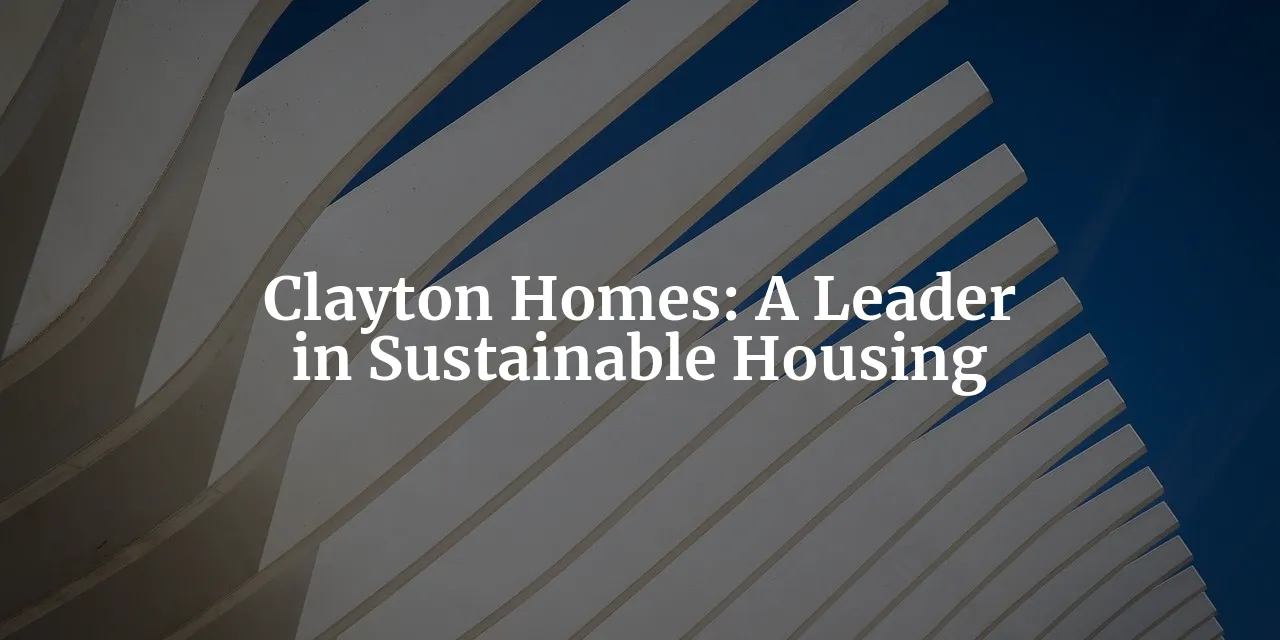Tags: Clayton Homes / Earnings / History
This fanpage is not officially affiliated with Berkshire Hathaway: Disclaimer
Calling all Berkshire Hathaway shareholders! Dive into the fascinating world of Clayton Homes, a leader in sustainable housing solutions. Explore its historic journey, current challenges and triumphs, and future outlook. Discover how Clayton Homes' strategic vision and innovative approach are shaping the future of affordable living in America.

Introduction
Clayton Homes, a subsidiary of Berkshire Hathaway, stands as the largest builder of manufactured housing and modular homes in the United States. Since its inception in 1956 and subsequent acquisition by Berkshire Hathaway in 2003, Clayton Homes has not only expanded its footprint across the nation but also solidified its reputation for innovation and sustainability in the housing sector ↗. Recent achievements, such as winning the 2023 ENERGY STAR® Residential New Construction Market Leader Award and breaking new ground with urban infill projects, underscore the company's commitment to excellence and forward-thinking. This article aims to provide Berkshire Hathaway shareholders with a comprehensive analysis of Clayton Homes' earnings, navigating through the company's historical financial performance, its response to market challenges and triumphs, and its strategic positioning for future growth. By leveraging facts from annual reports and industry predictions, we will craft a narrative that is as informative as it is engaging, offering insights into Clayton Homes' journey from a regional manufacturer to a national leader in affordable, sustainable housing solutions.
Historical Overview
The story of Clayton Homes is one of remarkable growth, strategic acquisitions, and innovative responses to an ever-evolving housing market. Founded by Jim Clayton in 1956, the company initially carved out a niche in the manufactured housing sector. Its acquisition by Berkshire Hathaway in 2003 for $1.7 billion marked the beginning of a new era of expansion and diversification 6. Since then, Clayton Homes has not only solidified its position as a leader in manufactured and modular housing but also ventured into the site-built housing market, aiming to make quality homes accessible to more Americans.
Post-acquisition, Clayton Homes embarked on a series of strategic expansions and acquisitions. Notable milestones include the introduction of the i-house in 2008, a modern, energy-efficient home design, and collaborations with entities such as Oak Ridge National Laboratory to innovate in housing technology 6. The company's growth trajectory was further bolstered by acquiring several homebuilding companies, including Georgia-based Chafin Communities in 2015 and Tennessee-based Goodall Homes in 2016, marking Clayton's earnest entry into the site-built housing market.
The evolution of the housing market, marked by the 2008 financial crisis and the COVID-19 pandemic, posed significant challenges and opportunities for Clayton Homes ↗↗. In response to the financial crisis, Clayton Homes focused on affordability and financial stability, which resonated with consumers facing economic uncertainty ↗. The pandemic era highlighted the importance of home as a sanctuary, accelerating demand for both manufactured and site-built homes. Clayton Homes' strategic response, emphasizing sustainability and energy efficiency, was epitomized by the 39 of its home building facilities winning the 2023 ENERGY STAR® award.
A historical analysis of Clayton Homes' revenues reveals a trajectory of growth punctuated by strategic responses to market dynamics. From a revenue of $3.66 billion in 2007, the company has navigated through economic downturns and booms alike 6. The introduction of innovative products and a focus on sustainability have not only helped in weathering the storm during the 2008 financial crisis but also positioned the company as a leader in affordable, energy-efficient housing. The COVID-19 pandemic, while initially disruptive, eventually led to an increased demand for homes, showcasing Clayton Homes' resilience and adaptability. As we shall see shortly, Clayton Homes revenues are significantly larger in 2023 compared to the years of the global financial crisis.
Clayton Homes' journey from a regional manufacturer to a national leader in the housing sector is a testament to its strategic vision, commitment to innovation, and responsiveness to market needs. As we delve deeper into the company's financial performance and strategic positioning, it is clear that Clayton Homes is not just building homes but shaping the future of affordable, sustainable living in America.
The Present Landscape
In the dynamic world of home construction and financing, Clayton Homes, a subsidiary of Berkshire Hathaway, stands as a beacon of both innovation and tradition. As of 2023, Clayton Homes has solidified its position in the industry with over 20,500 dedicated employees, delivering an impressive total of approximately 53,000 homes, split between off-site built and site-built homes 1. This monumental effort generated revenues of $11.4 billion, despite facing a decrease from the previous year 2.
The journey through 2021 and 2022 was fraught with challenges, notably input shortages and reduced labor availability, which notably increased construction times. However, the latter half of 2022 saw an improvement in the availability and pricing of key inputs, easing some of these constraints 1. Yet, the financial performance in 2023 paints a picture of resilience amidst adversity. A decrease in revenues and pre-tax earnings compared to 2022 underscores the impact of higher mortgage rates and increased operating expenses 2. Despite these hurdles, the financial services sector of Clayton Homes emerged stronger, marking a silver lining with growth amid the challenges faced in the home building business 2.
Below is a comprehensive summary of the past four years, revealing a substantial surge in both revenue and earnings for Clayton Homes. Earnings experienced a noteworthy ascent, progressing from around $1.2 billion to an impressive $2.0 billion. This achievement is particularly remarkable considering the prevailing macroeconomic conditions during that period 2345:
| Year | Revenues | Pre-tax Earnings | Key Factors |
|---|---|---|---|
| 2023 | $11.4 billion | $2.0 billion | Lower home sales, increased financial services earnings |
| 2022 | $12.7 billion | $2.4 billion | Increased home sales |
| 2021 | $10.5 billion | $1.7 billion | Higher home sales earnings, lower provisions for credit losses |
| 2020 | $8.6 billion | $1.25 billion | Increased site-built home sales, increased financial services earnings |
2023's $2.0 billion in earnings ain't too bad for a company that has been acquired for $1.7 billion in 2003!
Strategic acquisitions and expansions have been a cornerstone of Clayton Homes' approach to growth, especially in the site-built housing market. Since 2015, Clayton's site-built division, Clayton Properties Group, has acquired nine builders across 18 states, owning approximately 67,000 homesites with a home order backlog of $1.6 billion as of December 2023 1.
Furthermore, Clayton Homes has not only focused on expansion but also on sustainability. The company's efforts in building ENERGY STAR® certified homes and the introduction of eBuilt™ homes, which exceed ENERGY STAR® energy efficiency standards, have not only contributed to environmental protection but also significantly enhanced brand reputation and customer satisfaction 7. These homes, being at least 10% more energy efficient than local and state code requirements, have saved homeowners millions in annual utility bills, underscoring Clayton's commitment to affordability and sustainability 7.
Economic and Political Influences
The economic and political landscapes have played pivotal roles in shaping the performance and strategies of Clayton Homes. National economic trends, particularly interest rates and housing market dynamics, have had a significant influence. The past year witnessed significant increases in home mortgage interest rates in the U.S., which slowed demand for new home construction 1. However, experts are optimistic that mortgage rates will drop further in 2024, potentially revitalizing the housing market 9.
Federal regulations and policies in the housing and financial services sectors have also impacted Clayton Homes. The company's financing business, regulated by various agencies including the Consumer Financial Protection Bureau and the U.S. Department of Housing and Urban Development, makes expenditures for compliance with federal, state, and local environmental regulations 1. These regulations not only ensure the integrity of financial practices but also promote sustainable building practices, aligning with Clayton Homes' sustainability efforts. In turn, sustainable design is becoming a higher priority for home buyers 10.
The COVID-19 pandemic serves as a prime example of how global events can disrupt supply chains and labor markets. Clayton Homes navigated these challenges by adapting its operations to the changing circumstances, showcasing the importance of resilience and adaptability in the face of economic uncertainty 4.
The broader economic philosophy of Berkshire Hathaway, emphasizing long-term value creation and operational efficiency, aligns with Clayton Homes' strategies. This alignment has enabled Clayton Homes to navigate economic and political influences effectively, leveraging its strengths to capitalize on opportunities and mitigate challenges.
As we look to the future, the potential impact of economic policies, especially those related to housing and finance, looms large. Clayton Homes' ability to adapt and innovate will be crucial in navigating these waters. The company's track record of strategic acquisitions, focus on sustainability, and resilience in the face of economic challenges positions it well to continue thriving in the ever-evolving landscape of the housing industry.

The Future Outlook
As we gaze into the horizon of the housing market in 2024, several predictions stand out, particularly concerning mortgage rates and home affordability. Experts are optimistic about a decline in mortgage rates, which could herald a busier spring home-buying season. However, challenges persist due to high mortgage rates and home prices, which are expected to continue straining affordability for many potential homeowners 9.
In this evolving landscape, Clayton Homes is strategically positioning itself to navigate anticipated market conditions through a focus on innovation and sustainability. The company's recent accolades, including the 2023 ENERGY STAR® Residential New Construction Market Leader Award for 39 of its home building facilities, underscore its commitment to energy-efficient construction. This commitment not only enhances the company's product offerings but also aligns with a growing consumer demand for sustainable living options 7.
Moreover, Clayton Homes is breaking new ground with its urban infill projects and eBuilt homes, which represent a significant stride towards addressing the affordability crisis in the housing market. These initiatives are poised to open new segments for growth, leveraging technological advancements such as 3D printing to innovate product offerings and manufacturing processes. The CrossMod homes project in Atlanta, for example, showcases Clayton's ability to provide innovative housing solutions that promote attainable homeownership 8.
The role of financial services in Clayton Homes' future growth cannot be overstated. With loan balances increasing and financial earnings on the rise, primarily due to increased net interest income, Clayton Homes is well-positioned to leverage its financial services to foster customer loyalty and drive growth. This aspect of the business will be crucial as the company navigates potential challenges, including rising foreclosure rates and economic downturns 2.
Looking ahead, the long-term implications of current trends such as sustainability and affordability on Clayton Homes' market position are promising ↗. The company's strategic focus on energy-efficient homes and innovative housing solutions positions it well to meet the evolving needs of the market and maintain its leadership position in the industry.
Competitive Landscape
In 2023, the prevailing sentiment among the majority of Americans was that it was an unfavorable time for either selling or buying a home. Looking ahead to 2024, expectations point toward a generally challenging real estate market 10. In the competitive arena of homebuilding, Clayton Homes holds a unique position as the largest builder of manufactured housing and modular homes in the United States. This stature is supported by a strong focus on sustainability and energy efficiency, which not only differentiates Clayton Homes from its competitors but also aligns with a growing consumer preference for environmentally friendly living options. The company's receipt of the 2023 ENERGY STAR® Residential New Construction Market Leader Award for 39 of its home building facilities is a testament to its competitive advantage in this area 7.
Clayton Homes' financial services also play a pivotal role in enhancing its market differentiation and customer loyalty. The increase in loan balances and financial earnings, primarily due to increased net interest income, underscores the strength of this segment of Clayton's business. This financial stability and support offer a competitive edge, enabling Clayton Homes to retain customers and attract new ones in a challenging economic environment 2.
However, the competitive landscape is not without its threats. New entrants in the homebuilding technology space pose a potential challenge, especially those focusing on innovative solutions to housing affordability. Clayton Homes has responded to these challenges by investing in technological advancements, such as 3D printing, and by expanding its product offerings to include urban infill projects and eBuilt homes. These initiatives not only address the affordability crisis but also position Clayton Homes to remain competitive against new and emerging players in the industry 8.
Past successes in navigating competitive challenges, such as the acquisition of Georgia-based Chafin Communities and Tennessee-based Goodall Homes, illustrate Clayton Homes' proactive approach to enhancing its market position. These acquisitions, along with potential future partnerships or acquisitions, could further strengthen Clayton Homes' standing in the competitive landscape.
The importance of brand reputation and customer satisfaction in maintaining a competitive edge cannot be overstated. Clayton Homes' commitment to sustainability, innovation, and financial services has fostered a strong brand reputation and high levels of customer satisfaction. As the company continues to navigate the competitive landscape, these factors will be crucial in maintaining its leadership position in the homebuilding industry.

Shareholder Insights
For Berkshire Hathaway shareholders, Clayton Homes represents a significant and strategic component of the conglomerate's diverse portfolio. The financial performance of Clayton Homes not only reflects the health of the manufactured housing industry but also signals broader economic trends that can impact Berkshire Hathaway's overall performance. Here, we delve into the key takeaways from Clayton Homes' financial journey, its implications for shareholder value, and the risks and opportunities it presents in the current landscape.
Key Takeaways from Financial Performance
Clayton Homes has consistently demonstrated robust financial health, contributing positively to Berkshire Hathaway's bottom line. Its ability to maintain profitability and market share in the competitive landscape of manufactured housing is noteworthy. For shareholders, this translates to a stable and reliable source of dividends and potential for capital appreciation. The strategic acquisitions and diversification into financial services related to housing have further solidified Clayton's position, offering a more comprehensive suite of services to customers and a diversified revenue stream to investors.
Implications of Strategies and Market Position
The strategic positioning of Clayton Homes within the affordable housing segment, coupled with its vertical integration strategy—manufacturing, retailing, and financing—provides a competitive edge that is difficult for newcomers to replicate. For shareholders, this means a resilient business model capable of weathering economic downturns and capitalizing on growth during economic upswings. The focus on sustainability and innovation, especially in the development of eco-friendly and energy-efficient homes, aligns with growing consumer trends and regulatory demands, ensuring long-term relevance and growth potential.
Dividends and Growth Prospects
Clayton Homes' consistent performance and strategic growth initiatives bode well for continued dividend payouts and potential growth in shareholder value. The company's investments in technology and process improvements have enhanced operational efficiencies, contributing to healthier margins. For shareholders, the prospects of sustained dividends and appreciation in Berkshire Hathaway's stock price, partly driven by Clayton's contributions, are promising. However, it is crucial to monitor the broader economic indicators and housing market trends, as significant shifts could influence future performance.
Risks and Opportunities
The current economic and competitive landscape presents both risks and opportunities for Clayton Homes. Rising interest rates and a potential economic slowdown could impact the affordability of housing and financing, posing risks to growth. Conversely, the persistent demand for affordable housing, coupled with Clayton's innovative and sustainable housing solutions, presents significant growth opportunities. The company's ability to navigate regulatory changes and leverage technology for operational efficiency and customer engagement will be critical in capitalizing on these opportunities.
Recommendations for Shareholders
For shareholders considering their stake in Berkshire Hathaway, the outlook for Clayton Homes suggests a cautious but optimistic approach. Increasing one's stake could be justified by Clayton's solid market position, growth strategies, and contribution to Berkshire's diversified portfolio. However, it is essential to stay informed about broader economic conditions and the housing market's dynamics, as these could impact Clayton's performance. Diversification within Berkshire Hathaway's portfolio and monitoring Clayton's adaptation to economic and competitive challenges would be prudent.
The Role within Berkshire Hathaway's Portfolio
Clayton Homes plays a crucial role in Berkshire Hathaway's portfolio, offering stability, diversity, and growth potential. Its performance is a testament to Berkshire's strategic investment philosophy—acquiring companies with strong fundamentals, competitive advantages, and growth prospects. Clayton not only contributes financially but also exemplifies Berkshire's commitment to sustainability and innovation, key drivers of long-term value.
Importance of Sustainability and Innovation
Sustainability and innovation are increasingly critical in driving long-term shareholder value, and Clayton Homes is at the forefront of this movement within the manufactured housing industry. Its focus on developing sustainable, energy-efficient homes addresses the growing consumer demand for environmentally friendly living options and positions the company for future growth. For shareholders, this focus enhances Clayton's long-term prospects and aligns with broader societal trends, reinforcing Berkshire Hathaway's reputation as a forward-thinking and responsible investor.
Clayton Homes represents a vital and dynamic component of Berkshire Hathaway's portfolio, offering a blend of stability, growth potential, and alignment with future trends ↗. For shareholders, understanding Clayton's strategic position, market dynamics, and the broader economic landscape will be key to making informed investment decisions.

Conclusion
The journey of Clayton Homes, a subsidiary of Berkshire Hathaway, from its humble beginnings to becoming the largest builder of manufactured housing and modular homes in the United States is a testament to its resilience, innovation, and strategic vision. Through a historical analysis of Clayton Homes' financial performance, we have witnessed the company's ability to navigate through economic challenges, respond to market dynamics, and position itself for future growth.
The present landscape of Clayton Homes reflects a company that is adapting to changing market conditions, facing challenges such as input shortages and increased operating expenses while maintaining a focus on sustainability and innovation. The company's strategic acquisitions, expansion into site-built housing, and commitment to energy-efficient homes showcase its dedication to meeting consumer needs and staying ahead of the competition.
Economic and political influences have played a significant role in shaping Clayton Homes' strategies and performance. Federal regulations, interest rates, and global events like the COVID-19 pandemic have all impacted the company's operations, highlighting the importance of adaptability and resilience in the face of uncertainty.
Looking towards the future, Clayton Homes is well-positioned to capitalize on growth opportunities, particularly in the areas of sustainability, affordability, and financial services. The company's focus on innovation, strategic acquisitions, and customer satisfaction will be key drivers of its success in navigating the competitive landscape and delivering value to Berkshire Hathaway shareholders.
In conclusion, shareholders are encouraged to stay informed about Clayton Homes' strategic direction, market trends, and economic indicators to make informed investment decisions. The company's commitment to sustainability and innovation, coupled with its strong financial performance and strategic positioning, bodes well for its continued success within Berkshire Hathaway's diverse portfolio. By supporting Clayton Homes' initiatives and staying engaged with its progress, shareholders can contribute to the company's growth and long-term value creation.
References
-
2023 Annual Report - Building Products - Clayton - www.berkshirehathaway.com ↩↩↩↩↩
-
2023 Annual Report - Building Products - Clayton 2023 versus 2022 - www.berkshirehathaway.com ↩↩↩↩↩↩
-
2022 Annual Report - Building Products - Clayton 2022 versus 2021 - www.berkshirehathaway.com ↩
-
2021 Annual Report - Building Products - Clayton 2021 versus 2020 - www.berkshirehathaway.com ↩↩
-
2020 Annual Report - Building Products - Clayton 2020 versus 2019 - www.berkshirehathaway.com ↩
-
Clayton Homes - Wikipedia - en.wikipedia.org ↩↩↩
-
39 Clayton Home Building Group Facilities Earn 2023 ENERGY STAR® Award - www.prnewswire.com ↩↩↩↩
-
Clayton Breaks New Ground As Urban Infill Builder-As-A-Service - www.thebuildersdaily.com ↩↩
-
Housing Market Predictions For 2024: When Will Home Prices Be Affordable Again? - www.forbes.com ↩↩
-
5 Real Estate Trends That Will Rule the Market in 2024 - www.architecturaldigest.com ↩↩











